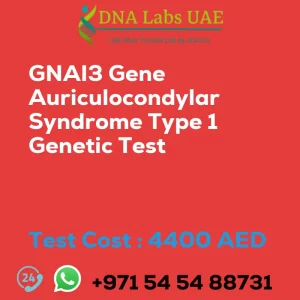PDGFRB Gene Basal Ganglia Calcification Type 4 Genetic Test
Components: PDGFRB Gene Basal ganglia calcification type 4 Genetic Test
Price: 4400.0 AED
Sample Condition: Blood or Extracted DNA or One drop Blood on FTA Card
Report Delivery: 3 to 4 Weeks
Method: NGS Technology
Test Type: Dysmorphology
Doctor: Pediatrics
Test Department: Genetics
Pre Test Information: Clinical History of Patient who is going for PDGFRB Gene Basal ganglia calcification type 4 NGS Genetic DNA Test. A Genetic Counselling session to draw a pedigree chart of family members affected with PDGFRB Gene Basal ganglia calcification type 4 NGS Genetic DNA Test gene PDGFRB
Test Details: PDGFRB gene basal ganglia calcification type 4 NGS genetic test is a type of genetic test that is used to detect mutations or variations in the PDGFRB gene that are associated with basal ganglia calcification type 4. Basal ganglia calcification, also known as Fahr’s disease, is a rare genetic disorder characterized by the abnormal accumulation of calcium in the basal ganglia and other brain regions. The PDGFRB gene provides instructions for making a protein called platelet-derived growth factor receptor beta. This protein plays a role in cell growth, division, and survival. Mutations in the PDGFRB gene can disrupt the normal function of the protein, leading to the development of basal ganglia calcification type 4. NGS, or next-generation sequencing, is a high-throughput DNA sequencing technology that allows for the rapid and simultaneous sequencing of multiple genes or even entire genomes. In the context of genetic testing, NGS can be used to analyze the entire coding region of the PDGFRB gene to identify any mutations or variations that may be present. By performing a PDGFRB gene basal ganglia calcification type 4 NGS genetic test, healthcare professionals can determine if an individual has any mutations or variations in the PDGFRB gene that are associated with basal ganglia calcification type 4. This information can be used for diagnosis, genetic counseling, and potentially for developing personalized treatment approaches in the future.
| Test Name | PDGFRB Gene Basal ganglia calcification type 4 Genetic Test |
|---|---|
| Components | |
| Price | 4400.0 AED |
| Sample Condition | Blood or Extracted DNA or One drop Blood on FTA Card |
| Report Delivery | 3 to 4 Weeks |
| Method | NGS Technology |
| Test type | Dysmorphology |
| Doctor | Pediatrics |
| Test Department: | Genetics |
| Pre Test Information | Clinical History of Patient who is going for PDGFRB Gene Basal ganglia calcification type 4 NGS Genetic DNA Test. A Genetic Counselling session to draw a pedigree chart of family members affected with PDGFRB Gene Basal ganglia calcification type 4 NGS Genetic DNA Test gene PDGFRB |
| Test Details |
PDGFRB gene basal ganglia calcification type 4 NGS genetic test is a type of genetic test that is used to detect mutations or variations in the PDGFRB gene that are associated with basal ganglia calcification type 4. Basal ganglia calcification, also known as Fahr’s disease, is a rare genetic disorder characterized by the abnormal accumulation of calcium in the basal ganglia and other brain regions. The PDGFRB gene provides instructions for making a protein called platelet-derived growth factor receptor beta. This protein plays a role in cell growth, division, and survival. Mutations in the PDGFRB gene can disrupt the normal function of the protein, leading to the development of basal ganglia calcification type 4. NGS, or next-generation sequencing, is a high-throughput DNA sequencing technology that allows for the rapid and simultaneous sequencing of multiple genes or even entire genomes. In the context of genetic testing, NGS can be used to analyze the entire coding region of the PDGFRB gene to identify any mutations or variations that may be present. By performing a PDGFRB gene basal ganglia calcification type 4 NGS genetic test, healthcare professionals can determine if an individual has any mutations or variations in the PDGFRB gene that are associated with basal ganglia calcification type 4. This information can be used for diagnosis, genetic counseling, and potentially for developing personalized treatment approaches in the future. |








